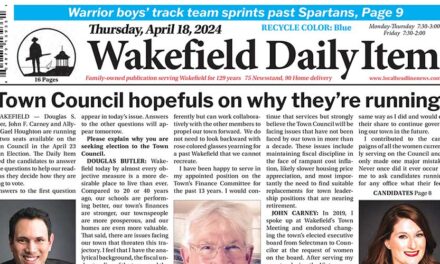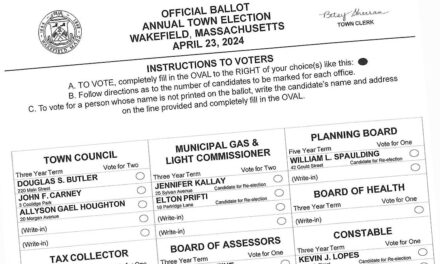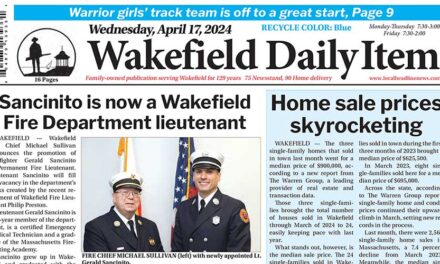Published in the May 8, 2018 edition.
By MARK SARDELLA
WAKEFIELD — After two and a half hours of discussion last night, an overwhelming majority of Town Meeting voters were convinced that the needs at the Public Safety Building warranted an $8 million building project under Article 8 to rectify those deficiencies.
Article 8 required a two-thirds majority and the 168-41 vote cleared that hurdle with room to spare.
After Permanent Building Committee Chairman Joseph Bertrand provided a brief history of the project that renovated the Public Safety Building in 2004, Police Chief Rick Smith used a PowerPoint presentation to present the case for approving the $8 million appropriation under Article 3.
Smith stressed that the current Police Station was not built 15 years ago as has been often stated publicly. The police side of the Public safety Building was originally built in 1950, he explained. He said that the police force has almost doubled in the number of officers in that time but the space has remained the same.
“We’re not talking about a 15-year-old building,” he said. “We’re talking about a 68-year-old building.”
Smith maintained that of the $10 million that was used to renovate and rebuild the Public Safety Building in 2004, the bulk was spent on the Fire Department side with less than $2 million spent on the police side.
Smith said that when he was hired as chief shortly after completion of the last renovation of the Public Safety Building, he knew that the space was too small for modern police needs and said so at the time. He insisted that the foremost deficiency that still needs to be addressed is insufficient space.
Another big problem, according to Chief Smith, is the location of dispatch on the second floor, leaving the lobby manned only from 8 a.m. to 2:30 p.m. weekdays by the public records officer.
He said that not having the lobby manned 24 hours-a-day presents a potential liability issue for the town if someone were to come into the building in dire need of assistance. Currently, during unmanned hours, visitors must pick up a phone in the lobby and ask for an officer to come down.
Smith showed slides to illustrate some of the issues with the building, including the tiny mental health clinician’s office and Family Service Officer’s office, both of which are converted closets, he said.
The roll call room is too small for daily briefings, he said, and none of the sergeants have their own desk. The conference room is so small, he said, that meetings of his entire command staff are held in a conference room on the Fire Department side of the building.
He pointed to air ducts that are spreading particles of debris as well as fumes from the tool room at the Fire Station. The sally port is too small to safely unload prisoners from cruisers representing a danger to both prisoners and officers, Smith said.
He showed a slide of water leak stains on the ceiling of the evidence room.
The Police Department, Smith insisted, “got nothing 15 years ago,” except “two walls moved and some nice paint on the walls. The town built an incredible fire facility but did not spend the dollars on the police side.”
To create sufficient space for the Police Department, Smith explained, would require bumping out the building on the Union Street side to match the Fire Department side. This expansion was just one of the recommendations of HKT Architects, the firm that was retained in 2016 to conduct a feasibility study of the building.
“For the services we provide, we need an updated, larger facility,” Smith said.
Finance Committee Chairman Daniel Sherman said that the FinCom supported the expenditure and the project unanimously.
Bob McLaughlin of Water Street noted that the town’s budget has gone from about $55 million in 2004 to about $95 million now. He talked about the resulting burden on the taxpayers as well as other upcoming, potentially expensive projects to deal with needs at the high school, the Greenwood School, Northeast Metro Tech and the DPW facility on North Avenue. He advocated making needed repairs to the Public Safety Building out of Capital Outlay over the next several years and then dealing with relocating dispatch after that.
Robert Mitchell of Spaulding Street claimed that he agreed that the issues that Smith had identified needed to be addressed but expressed concern about expanding the building footprint on a lot that is “already maxed out.”
Bronwyn Della-Volpe also acknowledged that deficiencies in the building need to be addressed but claimed that no breakdown of costs had been presented and people had not had enough time to study the floor plan and the costs.
She also wanted to know why it took so long for the chief to come forward with his concerns if they have been so longstanding.
Smith said that he told the selectmen in 2004 that the space was too small and the dispatch location was not working. He said that his officers lived with the newly refurbished building and tried to make the best of it, but the years have confirmed that it was not working.
“Policing has changed immeasurably since 2004,” Smith said. “I’m not here to talk about the sins of the past. This plan is for the future. We did our homework on this one.”
All seven members of the Town Council (formerly the Board of Selectmen) spoke in favor of the proposed Public Safety Building expansion/renovation proposed under Article 8.
Deborah Butler of Main Street said that she took the tour of the Public Safety Building that was offered in March. She said that, for her, the cramped quarters of the Family Resource Officer were “a compelling argument” for fixing the problems with the building.
Elizabeth Lowry of Green Street wondered why the PowerPoint presentation wasn’t offered before last night, insisting that it should have been on the town’s web site long ago.
Bertrand pointed out that the presentation had been made at a televised Board of Selectmen meeting last year and a building tour was done for the public.
David Watts of Greenwood Avenue said that there had been at least two separate programs in regular rotation on WCAT for the last few weeks that discussed the details of the Public Safety Building project.
In response to a question about liability as a result of the current building’s deficiencies, Town Counsel Thomas Mullen said that there were many reasons to address the issues with the building, but avoiding legal liability was not one of them. He said that the town was sufficiently protected legally and through insurance against any serious financial liability.
Charles McCauley of Lawrence Street wanted to know how much taxes would go up as a result to the Public Safety Building project.
Sherman said that it would not result in a tax increase because it was being done within Proposition 2 1/2 and within revenue projections.
Dennis Cloherty of Harvest Road said that the problem might not be that the building is too small. “The problem might be that we have too many policemen,” he said, suggesting that in the post “War on Drugs” era, far fewer police officers were needed. He added that it was unfair to burden taxpayers with this “white elephant.”
After two and a half hours of discussion, Elm Street’s Ami Wall moved the question, which was seconded.
Mitchell and Della-Volpe opposed moving the question, which would end discussion and put Article 8 to a vote, but Wall’s motion carried by the needed. two-thirds margin, 175-26.
The subsequent vote on Article 8 then easily surpassed the required two-thirds majority, 168-41.
—–
According to Town Clerk Betsy Sheeran, 118 voters were in the auditorium at the Galvin Middle School when last night’s session opened at 7 p.m. By 8 p.m., 212 were in attendance. That number increased to 230 by 9 p.m. Town Meeting adjourned at 10:06 p.m.




